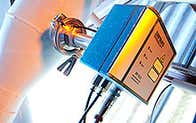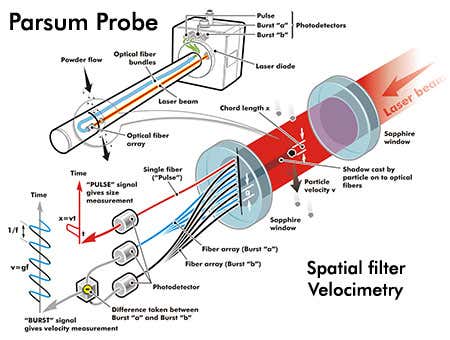
Parsum range
In-line probe that uses spatial filter velocimetry for particle size measur...
Using Spatial Filter Velocimetry, size and velocity can be extracted from particles as they pass through a laser beam and cast shadows on to a linear array of optical fibers.
A burst signal is generated due to the particle crossing fiber bundles labeled "burst a" and "burst b". The frequency of this signal is measured by photodetectors and is proportional to the particle velocity v. Knowing the spatial filter constant g, the velocity v can be calculated.
As the particle passes through the beam, a secondary "pulse" signal is generated by a single optical fiber. Knowing the time t of the pulse signal, and the velocity v of the moving particle, the chord length x of the particle can be calculated.

The actual particle size depends on the shape and the trajectory of the particle as it passes the laser. The measured value represents a chord length. By accumulating results from individual particles (typically 3000-10,000 particles over a period of 30-120 seconds), the chord length and velocity distributions are calculated. Parameters derived from the chord length distribution eg X(10), X(50) and X(90), can be correlated against other particle size analyzer results.


In-line probe that uses spatial filter velocimetry for particle size measur...
The Parsum probe works on a patented fiber optic particle counting principle. It simultaneously measures particle size and velocity of individual particles.
The instrument is able to determine particle count and size distributions based on statistics coupled with the Spatial Filter Velocimetry technique. The Spatial Filter Velocimetry technique is widely established and has been used to measure the velocity of objects for over three decades.

Parsum rangeIn-line probe that uses spatial filter velocimetry for particle size measurement |
|
|---|---|
| Measurement type | |
| Particle size | |
| Particle size range | 50µm - 6000µm |
| Technology | |
| Spatial filter velocimetry | |
| Dispersion type | |
| Wet | |
| Dry |